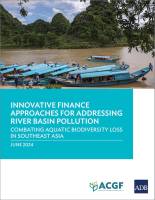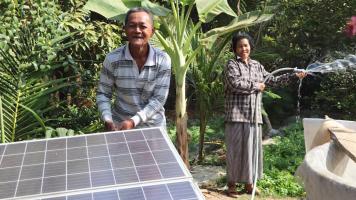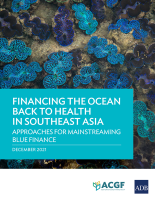Fishermen in the Gulf Of Thailand bring in their catch. Photo credit: iStock/GarySandyWales.
A project in Cambodia uses an innovative solution that deters illegal fishing and helps restore damaged marine and coastal ecosystems.
Fishery is an important sector in Cambodia. It contributes 8% to 10% of the gross domestic product and provides livelihoods to millions of people, especially in the coastal areas. It is also vital to ensuring healthy diets and food security. Next to rice, fish is the most consumed food in the country.
However, ADB research shows overfishing has led to the sharp decline in fish stocks by 40%–60% from 2017 to 2022. Mangrove loss and the deterioration of seagrass beds due largely to bottom trawling practices have reduced the productivity of fisheries. Fish stocks are projected to decline further by 30% in the next 5 years unless coastal and marine ecosystems are strengthened. Risks include ocean acidification and warming.
Since 2018, the country’s Fisheries Administration, in partnership with Marine Conservation Cambodia, has been deploying large passive structures that enhance fish productivity and protect critical habitats of endangered species, such as the Irrawaddy dolphin, dugong, sea turtles, and sea horses. Marine Conservation Cambodia, a community-based NGO, developed low-cost and easy-to-build modular concrete structures designed to counter destructive and illegal fishing practices. The initiative, which focused on Kep province’s marine fisheries management area (MFMA), has achieved positive results in rehabilitating coral reefs and seagrass meadows and improving fish biomass and diversity.
Scaling up deployment
In 2022, ADB approved a $73 million financing package, with cofinancing from the Agence Française de Développement, that includes support for the expanded deployment of these fish productivity structures to MFMAs in Cambodia.
The project will help four coastal provinces—Kampot, Kep, Koh Kong, and Preah Sihanouk—regenerate nearshore fisheries and restore seagrass beds and mangroves. It will also enable coastal communities and small businesses to diversify their livelihoods and adopt sustainable practices, such as open water non-fed mariculture and ecotourism.
The project seeks to strengthen Cambodia’s marine fishery while supporting its contribution to shared fish stocks and ecosystems in the Gulf of Thailand.
The use of fish productivity structures is a key element of the project’s strategy. The plan is to deploy 5,000 structures across nearly 40% of the nearshore fishery to increase productivity by preventing harmful fishing practices and protecting immature or juvenile fish in particular from being caught.
How the structures work
Marine Conservation Cambodia engages local communities to build and deploy the fish productivity structures. Large interlocking blocks are made from concrete and rebar and then assembled under water to form a full structure.
The structures are designed to delimit the boundaries of a marine protected area and serve as barriers against illegal bottom trawling. The nets of trawling vessels get caught on them. The deployment of these structures in the Kep MFMA has reduced the need to patrol the area, resulting in an estimated 500,000 liters in fuel savings per year.
The concrete blocks also provide a substrate for an artificial reef and habitat for juvenile fish as well as opportunities for commercial mariculture. In Kep, the structures were seeded with locally grown oyster spats, which not only provides another source of livelihood for communities but also helps filter water.
In the ADB-supported project, the local communities will make the large modular blocks under a wage-for-work program. The Fisheries Administration will continue to work with Marine Conservation Cambodia and community fisheries to deploy the structures in deeper water. Concrete blocks will also be placed along the seafront of mangroves and form a corridor toward seagrass beds to serve as fish nursery zones.
Sustainable livelihoods
Another important element of the project is expanding seafood production from sustainable mariculture to help coastal communities develop viable and sustainable businesses. This entails promoting open-water mariculture of high-value, short-life cycle species like crabs, mussels, oysters, and cockles.
State-run Khmer Enterprise will offer a marine business incubator program for small and medium-sized enterprises, targeting women-led businesses in particular, and provide entrepreneurship training and assistance in conducting feasibility studies.
Overall, the project is expected to benefit 25 community fisheries organizations and members of 15 community-protected areas, comprising nearly 20,000 households, as well as a wider coastal community of about 200,000 people.


